Well worth reading this as it is the history of it all. It shows how broilers have been maxed out. Yet this is a local phenomena in time and space. The future will change all that.
We need massive numbers of meat chickens to work behind the cattle. That alone will massively shift the chicken meat back into our food chain as a premium product.
Those field chickens will be several pounds in weight.
.
From farm to factory: the unstoppable rise of American chicken
How industrial chicken farming transformed an ‘alternative’ meat to the most consumed meat in the US
Animals farmed is supported byAbout this content
Sarah Mock
Mon 17 Aug 2020 07.30 BST
The modern US poultry industry is highly optimised to produce the most meat for the lowest costs.
A century ago, Americans would not recognise our modern hunger for chicken. The year-long market for tender but relatively bland chicken meat is a newish phenomenon, and without it the idea of chicken cutlets, $5 rotisseries, or the McNugget would be a fantasy.
How did America go from thinking of chicken as an “alternative” meat to consuming it more than any other meat?
The story starts with corn.
How American corn fueled a taste for chicken
At the turn of the 20th century, chicken was almost always eaten in the spring. The priority for chicken raisers at the time was egg production, so after the eggs hatched, all the male birds would be fed up and then quickly harvested as “spring chickens” – young, tender birds that were sold whole for roasting or broiling (hence the term “broilers”). Outside the spring rush, you might be buying a bigger, fatter fryer or an old hen for stewing.
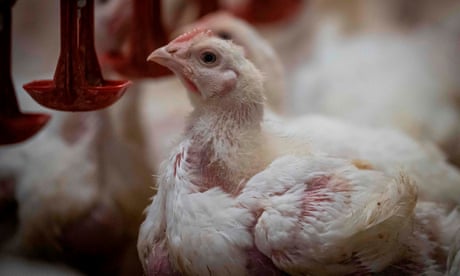
KFC admits a third of its chickens suffer painful inflammation
Read more
“Farmers were sending chickens of all sorts of ages, different feather colours, and tremendous variety to the marketplace in the early 20th century,” says Roger Horowitz, food historian and author of Putting Meat on the American Table. But almost all chickens in the market were simply surplus to egg production, making them relatively uncommon – even rare. Tender spring chickens in particular could fetch a good price. But it is worth noting, Horowitz says, that the higher price wasn’t necessarily coming from pent-up demand.
“It’s not as if consumers were clamoring for broilers,” he says. Though there was some consumer demand for chickens, the relatively high price for broilers likely had more to do with the limited, seasonal supply than a passion for poultry.
FacebookTwitterPinterest In the early 20th century there was a ‘tremendous variety’ of chickens in the US marketplace. Photograph: Historical/Corbis
During the second world war, however, red meat was rationed, and a national campaign encouraged the consumption of poultry and fish to save “meat” (beef, pork and lamb) for “the army and our allies”. Eating chicken became more common, but the preference for young broilers, and white breast meat, persisted.
As the war drew to a close, feed millers, which buy and grind corn and other grains to feed livestock, saw a big opportunity to spur that demand for meat chickens, which consume large amounts of corn. When traditional banks refused to finance new-fangled “chicken farms”, the feed companies themselves offered farmers loans to buy feed and equipment, putting the pieces of the modern contract poultry system in place.
It might surprise you to learn that every nugget, breast, and cup of chicken noodle soup you’ve ever eaten likely came from one breed
Consumer acceptance of broilers out of season was not automatic. In the 1930s, the average American ate 10lbs (4.5kg) or less of chicken annually; by 2017 that had risen to 64lbs (29kg), according to the Economic Research Service at the United States Department of Agriculture (USDA). For decades chicken battled to be seen as a “meat”, and did not surpass its most expensive competitor, beef, in terms of overall consumption until 2010. A strong USDA-funded marketing campaign helped out.
“In the 50s and 60s, you see where these agricultural extension operations start pushing out recipes very aggressively about broilers,” Horowitz says, and as feed companies and hatcheries (most of which would eventually become so-called “integrators”, which own several of the businesses involved in chicken production) continued to consolidate the industry, they were able to more carefully calibrate the chicken itself to what would sell most profitably, focusing on lowering costs and raising proportions of the highest-demand cuts, namely breast meat.
Don Tyson, the late president of Tyson Foods, famously said: “If breast meat is worth two dollars a pound and dark meat is worth one dollar, which would I rather have?” But for generations, the idea of buying just the most coveted cuts of chicken was foreign to most consumers. It wasn’t until the 1980s that preferences began to switch to cuts of meat over the whole bird.
These companies owned and understood their chickens from egg to table and were able to exert unprecedented control over the biology of their flocks. Now, not only are they able to fine tune the birds’ characteristics with incredible accuracy, they can also map interactions with feed, environment, and processing to maximise profits.
For integrators and corn farmers alike, the investment paid off. In 2019, 9.2 billion 6lb (2.7kg) broiler chickens were harvested in the US, consuming about 1.8lbs (820g) of grain for every pound of chicken.
But the impact on chickens from the changes in production is troubling.
The modern industrial chicken
Over the past 70 years, the poultry industry has measured its success in terms of how many pounds of meat a chicken can produce for a given amount of feed. Modern chickens are more efficient than ever, with producers able to calculate to the ounce how much “input” of food, water, air and time are required to get a set amount of white and dark meat.
The modern chicken is fully industrialised.
FacebookTwitterPinterest The Cobb 500 chicken is optimised for its large breasts, white feathers and efficient growth. Photograph: Peter Caton/The Guardian
Advertisement
The genetic lineages of chickens grown by the world’s biggest poultry companies are a closely guarded secret. But one common commercial line, the Cobb 500, originated from a contest held by the USDA’s Agricultural Extension Service in the 1940s, aptly titled the “chicken of tomorrow” competition. The winner, the Vantress chicken, would become the standard meat chicken by the 1950s. This chicken and its many descendants were optimised for a few key factors: large breasts, white feathers, fast and efficient growth, consistent sizes and gentle dispositions.
The average size of a grocery store chicken in the 1920s was about 2.5lbs (1.13kg). Today it hovers around 6lbs (2.7 kg), which a broiler chicken can reach in about 47 days, according to the National Chicken Council (even younger, smaller birds are used for fast food restaurants).
Food movements are spurring conversations about making slower-growing chickens of different breeds, harvested at a larger variety of ages, more widely available
The use of naturally double-breasted breeds and millions of dollars in research has produced birds with massive breasts, but gaining that muscle mass quickly requires near constant food consumption, and leads the birds to have much lower activity levels. Growing pains lead to sedentary birds.
“They actually have robots on wheels that go around the [poultry] house and inspect the birds with a camera and force the birds to move so that they walk more,” says Phillip Clauer, associate teaching professor at Penn State Extension.
White feathers are key for marketing, because pin feathers and follicles of birds with coloured feathers can hang on to pigmentation, and coloured bird carcasses don’t appear as “clean” or sell as well to picky consumers.
Consistent sizing is required to ensure that slaughterhouse line speeds can stay high. Processing chickens is one of the biggest bottlenecks in getting chickens from farms to grocery stores, and consistently sized birds keep the machines running smoothly..
FacebookTwitterPinterest Consistently sized birds help to keep slaughterhouse lines running smoothly.
Gentle dispositions are also a must as chickens are naturally aggressive and even cannibalistic, especially in confined spaces and large numbers. Poultry houses are more profitable the more birds are inside, so reducing the chickens’ natural disposition to fight and eat one another is key to facilitating modern poultry rearing. Faster-maturing birds also tend to be gentler, because aggressive behavior is more common among sexually mature chickens, a milestone most broilers never reach.
With limited diets, these industrial birds can live semi-normal lifespans, but if allowed to eat continuously, as they are genetically designed to, they tend to have extremely high mortality rates beyond the ideal harvest date.
Niche markets

Animals farmed: join us for monthly updates
Counterintuitively perhaps, the industrialisation of chicken led to far fewer choices when buying poultry.
“If you look at cookbooks in the 20s and 30s – for a certain kind of dish you get a fat chicken, for another you get a fryer or broiler. And the marketplace distinguished between those kinds of chickens,” Horowitz says. The industry’s obsession with perfecting the broiler machine came at the cost of the consumer’s ability to choose other varieties of chicken.
As chickens became more commonplace in grocery stores, brands started to reintroduce variety by offering individual cuts, skinless and boneless meats, and processed products (which also allowed them to improve the flavour, which had become decidedly bland over time). But as consumers’ interests trend away from more highly processed foods in search of story and connection to place, a niche may
be opening for birds other than the Cornish cross.
FacebookTwitterPinterest Food movements have called for the diversification of chickens available to consumers. Photograph: İsmail Duru/Anadolu Agency
Growing food movements around the world are already spurring conversations about the possibility of making slower-growing chickens of different breeds, harvested at a larger variety of ages, more widely available. Even the company that grows Cobb 500 chicks is offering a new “rustic” variety with golden plumage, rather than the standard white.
The conventional poultry industry may actually be poised to lead this trend, as it currently makes chickens of various sizes and ages available to institutional customers (fast food fried chicken, for example, is usually made from smaller, younger birds than are available in the grocery store).
In the meantime, breeders and geneticists at the world’s largest poultry companies will continue refining their lines of Cornish cross broilers, in particular to grow quickly in harsh environments or on lower-quality feeds, conditions that might be more common in the developing world.
Advertisement
“Instead of just selecting birds for maximum growth and size,” says Clauer, “now the genetic companies can look at 20, 30, 40 parameters and look very closely at the bird’s anatomy, health, structure, all the things that go into a modern bird that makes it much more efficient and have better liveability.”
Though competition will likely come as technologies around lab-cultured and cell-based meats continue to progress and gain consumer acceptance, the sheer efficiency and short growth time of chickens is insulating the industry for now.
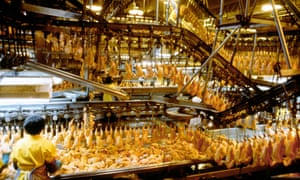
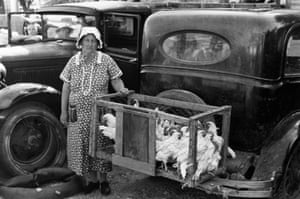
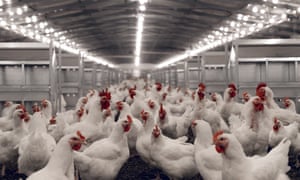

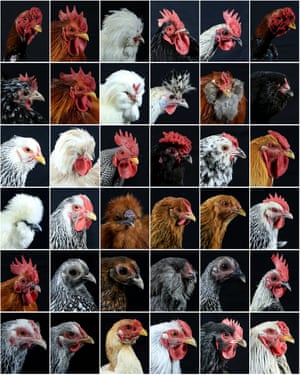
No comments:
Post a Comment